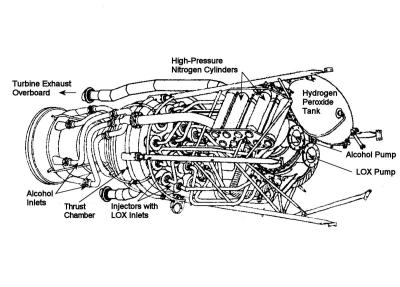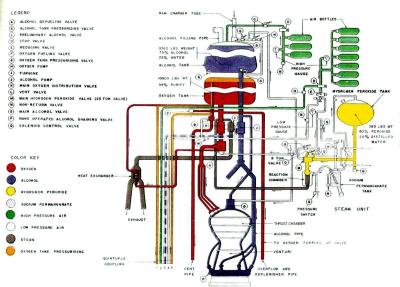

German V-2
Compiled by Kimble D. McCutcheon
Unless Noted Otherwise, Photographs by Kimble D. McCutcheon
| The German V-2 (also known as the A-4 during development) is the rocket from which nearly all US space launch systems evolved. It was developed during the late 1930s and early 1940s. More than 6,000 were built, and more than 3,000 were launched against targets in the United Kingdom and Europe. |
The V-2 was a sophisticated, 23,000 lb (gross weight), short-range (200 mi), ground-to-ground guided missile that included a gyroscopic guidance system, a 2,200 lb warhead, and a rocket engine that used a mixture of 75% ethanol and 25% water for fuel (alcohol), and liquid oxygen (LOX) as an oxidizer. During its typically 60-sec burn, the engine produced about 55,000 lbT at launch, which pushed the rocket to an altitude of around 60 mi.
Each second, a steam-driven turbopump fed 128 lb of alcohol at 333 psi and 158 lb of LOX at 254 psi into the thrust chamber. The alcohol and LOX burned to produce a pressure of 218 psi. Steam for the turbopump was generated by catalyzing hydrogen peroxide with sodium, potassium, or calcium, permanganate. The exhaust steam was vented overboard, and did not contribute significantly to the total thrust, resulting in a specific impulse of around 203 seconds at sea level, and 239 seconds in a vacuum. (Specific Impulse is a measure of reaction engine efficiency; the higher, the better).Another factor that limited specific impulse was the straight-sided divergent section of the nozzle. Rocket engine designers would later discover that bell-shaped nozzles were more efficient.
V-2 Engine Component Overview
V-2 Engine Component Details
V-2 Engine Thrust Chamber Details
Alcohol and LOX were burned in 18 burner cups at the top of the engine, all of which fed a common thrust chamber. Alcohol via 6 pipes spread around the engine base. Before the alcohol was burned, it was used to cool the engine by circulating through a space between the inner and outer thrust chamber walls. This is called regenerative cooling. In addition, four rings of small holes allowed some of the alcohol to bleed into the thrust chamber and nozzle, where it evaporated and formed a layer of vapor that protected the thrust chamber and nozzle walls. This is called transpiration or film cooling.
The warmed alcohol finally made its way to the burner cups, where most of it was burned. Excess alcohol was returned to the alcohol pump inlet via a mixing valve and pipe that exited at the center of the injector assembly.
For Further Study...
There is an enormous amount of information about the V-2, its developmet, and its role in the US missile and space programs on the Internet. To get started, please see
http://www.v2rocket.com, http://www.astronautix.com/v/v-2.html, and http://heroicrelics.org/info/v-2/combustion-chamber-cut-away.html